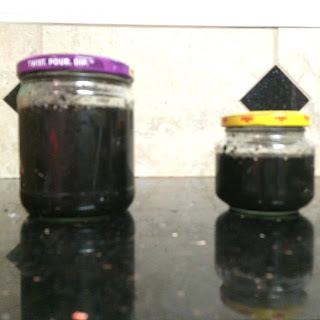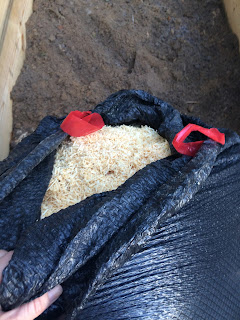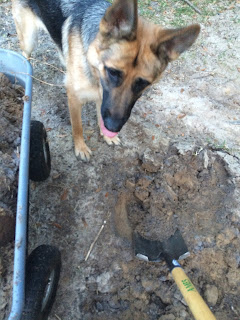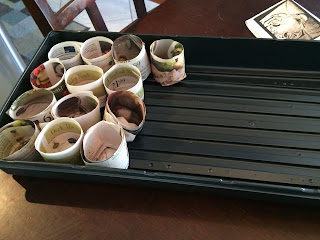I have been busy with various projects around the house, and time has slipped away from me. My seedlings are way behind schedule. I need to get them started again. I'm not exactly sure what went wrong with them. Maybe it was the compost in the cups, or perhaps it was a little too chilly in the house.
My compost piles have been coming right along. I was finally able to chainsaw down the tree that fell into our yard after a big storm. I have added it to my open compost pile. It doesn't look like much all chopped up, but it seemed like a big undertaking. This was my first time using a chainsaw. I was surprised at how much it kicked and jerked when it grabbed the dead tree.
Largo sure liked the perched I fashioned for her from a branch of the downed tree.
I have also been collecting spend coffee beans from my local Starbucks for my bin compost. On several occasions, I have added large batches of spent coffee beans to my compost. As usual, I make almost every meal at the house, so I have added all the left over kitchen and veggie scraps to the compost bin. I've been shredding paper grocery bags to make sure my "browns and greens" are properly mixed. I am looking forward to emptying the bin and attempting the new compost method I talked about earlier.
In the meantime, I've been meeting new people and learning new things about my new local area. So far, I've learned that we have primarily a sanding soil here which tends to be well drained. I met a man that makes furniture, and he politely offered me all the shavings from his workshop for my garden. This afternoon my new friend made good on his promise and delivered to me two large bags of sawdust from untreated lumper for my garden.
I am trying to achieve multiple goals by using the soil from my yard to fill my garden box. First, I did the math on buying garden soil, and the total would run in the neighborhood of $400. I really want my gardening hobby to be a cheap hobby, so I wanted to utilize the free soil from my own yard to fill up the bottom layers of the box. I plan to dig in some compost and finish with a layer of good gardening soil on top.
Second, I've been meaning to alter the drainage pattern of my backyard, and redirect the water pattern away from the house. I have been wanting to move some soil around to help with the drainage issue where the water tends to pool on my patio. I have a feeling there will be a lot more work in leveling the yard, but at least this is a small dent.
Because I received that delivery of sawdust and shavings, I decided to roll up my sleeves after work and get to work in the garden. In anticipation of the sawdust, I had been contemplating how to best utilize it for weeks. Since this soil and shavings are going to be pretty far down in my garden bed, I am thinking there is no need to compost them ahead of time. I've spent a good deal of time thinking about if I would add the shavings directly too my raised bed, or if I should compost it first. I'm unsure how this may affect the Ph of my soil. The place to which it is being added is much deeper than any of the roots will likely reach. At this point I'm unsure if I'll be simply fertilizing the deeper soil to no eventual benefit for the raised bed. In other words, are nutrients going to seep downwards and make no difference to the upper layers. Ultimately, I decided to stop over thinking everything.
What I settled on was a "layered and wait" approach. I started by placing one thin layer of sand on the cardboard boxes, followed by the two bags of shavings.
And I had a helper this time! I added two wagons full of dirt to the bottom layer.
Here are the shavings going in onto of the dirt layer….
The second layer is complete, and there was a lot of shavings to go around.
After the second layer was complete, I moved onto the last layer of soil. Perhaps the natural composting that will occur will be enough that the garden is better than it would have been with just sand.
And another helper!
After three more wagons of dirt, I think I'm done!
I have a party at the house this weekend, so hopefully on Sunday I'll have the time to start some seedlings for the garden. The weather here is beautiful. I wish I had some plants to harden off right now, but such is life. I will have a shorter growing season this year, for this area, but it will still be longer than most areas!


















































